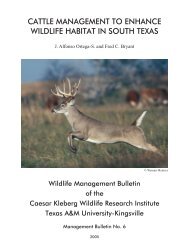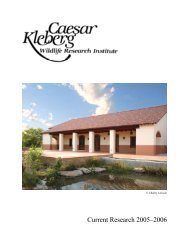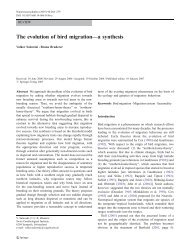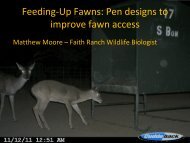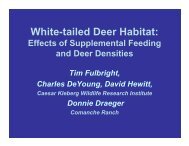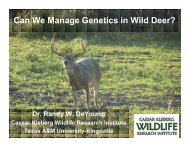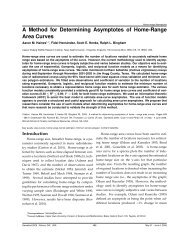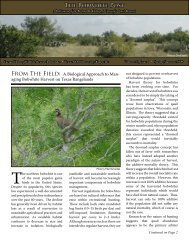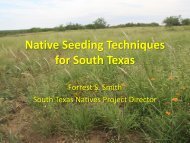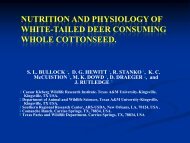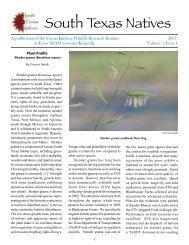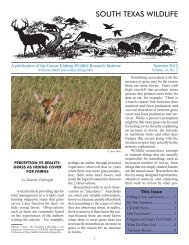118 DENSITY DEPENDENCE IN YELLOWSTONE ELK * Taper <strong>and</strong> GoganJ. Wildl. Manage. 66(1):2002DISCUSSION<strong>Density</strong> dependence in the population growthrate of the northern <strong>Yellowstone</strong> elk herd isstrongly supported by several aspects of ouranalysis. First, a true a priori test (Dennis <strong>and</strong>Taper 1994) rejects the null hypothesis of densityindependence. This is more significant than thetest of density dependence for this populationreported in Dennis <strong>and</strong> Taper (1994). Two differencesbetween the current analysis <strong>and</strong> that ofDennis <strong>and</strong> Taper (1994) account for this change.First, we include the late period in our analysis,while Dennis <strong>and</strong> Taper (1994) worked just withthe early period. Second, we adjust for huntingmortality while Dennis <strong>and</strong> Taper (1994) did not.Perhaps, more appropriately, model identificationalso strongly supports density dependence inthe elk herd. In comparing the best density-independentmodel to the best density-dependentmodel, we find a AIC of 5.74. This indicates densitydependence is more than 300x more stronglysupported by the data than is the absence ofdensity dependence.Currently, the <strong>Yellowstone</strong> northern elk populationis capable of regulating itself. <strong>The</strong> populationequilibrium numbers in the absence of hunting(based on minimum counts) seem to besomewhere between 20,000 <strong>and</strong> 25,000 elk for thesize <strong>and</strong> quality of the current winter range.Undoubtedly, this underestimates the equilibriumpopulation size somewhat because of sightabilityissues.Our analysis indicates that although estimatesof the area of expansion are crude, the bulk ofthe population increase can be attributed to theexpansion of winter range to the north of YNP.Range expansion directly reduces density by increasingthe denominator in the ratio of populationsize to area occupied. Further, range expansionmay have a negative density-dependenteffect as the energetic dem<strong>and</strong>s of longer migrationsincrease at greater population sizes(Messier et al. 1988).Environmental changes have been involved to alesser extent in the increase in ecological carryingcapacity in the late period. Spring precipitationof the current year <strong>and</strong> spring precipitationsquared were identified as contributing effects.Calf:female ratios have been correlated positivelywith winter <strong>and</strong> summer precipitation 2 years earlier<strong>and</strong> negatively correlated with the previousyear's spring precipitation for 1970-1971 through1990-1991 (although the latter relationship wasonly marginally significant; Coughenour <strong>and</strong>Singer 1996). Other variables are included inmodels not statistically distinguishable from themodel including only current spring precipitation<strong>and</strong> density (Fig. 5). Further, the weathervariables are correlated, <strong>and</strong> thus, the identificationof predictive variables is not stable (Neter etal. 1996). A more secure statement is that environmentalfactors do contribute to elk populationdynamics.Singer et al. (1997) reported that Fames'(1996) winter severity index for the current yearwas not correlated with over-winter survival of elkcalves for winters 1968-1969 through 1991-1992.However, between 1987-1988 <strong>and</strong> 1990-1991,summer survival of radiocollared elk calves wasnot correlated with current year precipitation<strong>and</strong> over-winter survival of these calves was correlatedwith Fames' (1996) winter severity index forthe current winter. This may indicate an interactionbetween the effects of density <strong>and</strong> environmentalvariation in which winter severity has amore profound impact on calf (<strong>and</strong> adult) survivalunder conditions of high density. This patternhas been reported in other ungulate populations(Clutton-Brock et al. 1987, Choquenot1991). Winter carcass surveys during the lateperiod (Green et al. 1994) show a strong (adjustedR2 = 0.73) <strong>and</strong> significant (P= 0.02) regressionof elk carcasses on Fames' winter severity index(C. Schwartz, U.S. Geological Survey, personalcommunication).Our comparison of predicted <strong>and</strong> observedgrowth rates following the 1988 fire corroboratesthe simulation findings of Turner et al. (1994)that predicted a mild, but short-lived, increase inelk growth rate due to fire. Boyce <strong>and</strong> Merrill(1996) also modeled a post-fire peak <strong>and</strong> declinein the population size of the northern <strong>Yellowstone</strong>elk herd. However, the timing of the peak<strong>and</strong> the rate of return to background levels weobserve are much more rapid than thoseassumed by Boyce <strong>and</strong> Merrill (1996). Thus, inagreement with empirical work (Pearson et al.1995, Boyce <strong>and</strong> Merrill 1996, Vales <strong>and</strong> Peek1996) <strong>and</strong> the simulations of Turner et al. (1994)<strong>and</strong> Wu et al. (1996), we found that the 1988 firewas not responsible for the large decline in theherd from 1989 to 1990. <strong>The</strong> high 1988 populationsize <strong>and</strong> severe spring drought accounted forvirtually the entire decline. We also support theconclusions of these researchers that there was ashort-lived enhancement to elk habitat after thefire. This boost seems to have been in effect duringthe 1991-1992 <strong>and</strong> 1992-1993 years.
J. Wildl. Manage. 66(1):2002DENSITY DEPENDENCE IN YELLOWSTONELK * Taper <strong>and</strong> Gogan 119During recent years, there has been a growing iarityinterest in underst<strong>and</strong>ing the potential of nonlinearityin density-dependent population dynamics(Fowler 1994, Clutton-Brock et al. 1997, Higginset al. 1997, Ellner et al. 1998, McCullough 1999).An important aspect of this study is that fertility<strong>and</strong> adult survivorship have distinct nonlinearrelationships with density. When these 2 relationshipsare coupled through a simple demographicmodel, a biphasic or ramped density dependencecurve emerged. Ramps in growth rate/densitycurves have been considered by other authors(Fowler 1980, 1981; McCullough 1990, 1992,1999). In these papers, the ramp was generatedby a physiological maximum to reproductive rate.Thus, our observation that different demographicrates can have distinct density-dependent rela-tionships, which can combine to yield rampeffects, is a previously unidentified mechanismfor generating nonlinearity in growth rates.<strong>The</strong>se datasets are unusual in following growth ofa population from very low levels to near carryingcapacity. Most studies are restricted to a muchnarrower range of population sizes making it difficultto detect ramp effects or density dependencein adult survival (Gaillard et al. 1998). Yetpredictions of expected time to recovery of adepleted population or expected time to extinctionmay be biased by neglecting these changesin the slope of density dependence function (Pascualet al. 1997).Eberhardt (1977) suggested that density-dependentresponses in life history should follow theorder: (1) juvenile survival, (2) age of first reproduction,(3) adult reproductive rate, <strong>and</strong> finally(4) adult survival. We are not able, given thedata, to distinguish life-history stages 1 through 3.<strong>The</strong>y all contributed to the fertility we estimate.However, the onset of density dependence inadult survival is at a much higher population levelthan for fertility (Figs. 7, 8). An interesting fea-ture of the density dependence of fertility is it isconcave (Fig. 7). This contrasts with observationson a number of other ungulate species reviewedby Fowler (1994). A further contrast between thisstudy <strong>and</strong> reviews of ungulate dynamics is thepresence of density dependence in adult survival.Gaillard et al. (1998) indicated that densitydependence in adult survival seems rare.Our analysis is unable to distinguish betweenmortality <strong>and</strong> emigration. Thus, it is possible thatthe declines in adult survivorship observed athigh densities are the result of adults permanentlyleaving the herd. Experts with long famil-with the herd do not believe this is the case(D. B. Houston, U.S. Geological Survey, personalcommunication). Smith <strong>and</strong> Anderson's recentstudy (2001) of dispersal in the nearby Jacksonelk herd (Gr<strong>and</strong> Teton National Park) indicatesthat mature adult elk are extremely herd faithful.<strong>The</strong> little dispersal that did occur was by juveniles,<strong>and</strong> did not appear in their study to have adensity-dependent component. Further, mortalityof dispersers from the Jackson herd was muchgreater than that of nondispersers.MANAGEMENT IMPLICATIONSManagement of the northern <strong>Yellowstone</strong> elkherd has been controversial throughout the 20thcentury. Between 1935 <strong>and</strong> 1968, annual reductions(by trapping <strong>and</strong> shooting) inside <strong>and</strong> outsideYNP removed 1,500animals from the northern <strong>Yellowstone</strong> elk herdby sport hunters (Lemke et al. 1998).<strong>The</strong> increase in the size of the northern <strong>Yellowstone</strong>elk herd has been concomitant with amajor expansion of the herd's winter rangebeyond the YNP boundaries (Lemke et al. 1998).At present, a variable portion of the herd movesduring each fall <strong>and</strong> winters north of YNP onother public (chiefly USDA Forest Service) <strong>and</strong>private l<strong>and</strong>s where management authorityresides with the Montana Department of Fish,Wildlife <strong>and</strong> Parks (MDFWP; Lemke et al. 1998).This expansion has been in part facilitated <strong>and</strong> sup-



